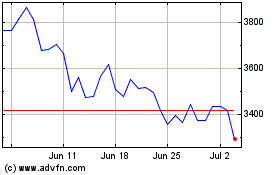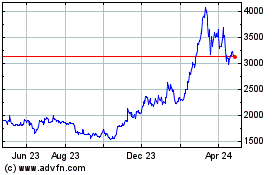Bitcoin ‘Realized Volatility’ Showing Very Rare Trend: What Could Be Next
May 31 2024 - 6:00PM
NEWSBTC
Data shows that the Bitcoin Realized Volatility metric has fallen
to historically low levels. What generally happens after this
pattern forms? Bitcoin Realized Volatility Has Decline To Extreme
Lows Recently In a post on X, CryptoQuant author Axel Adler Jr has
discussed about the latest trend taking place in the Realized
Volatility of Bitcoin. The Realized Volatility here refers to an
indicator that basically tells us about how volatile a given asset
has been based on its price returns within a specified window. When
the value of this metric is high, it means that the asset in
question has experienced a large number of fluctuations during the
period. On the other hand, the low indicator implies that the price
action has been stale for the commodity. Related Reading: Ethereum
Investors Take On Sky-High Leverage: Brace For Volatile Storm? Now,
here is a chart that shows the trend in the 1-week Realized
Volatility for Bitcoin over the last few years: As displayed in the
above graph, the 1-week Bitcoin Realized Volatility has declined to
pretty low levels of around 7% recently. This is so extreme that
only ten other instances in the past six years have seen the metric
go similarly low. This means that the cryptocurrency’s recent
consolidation has been amongst the tightest in its history; as for
what this trend in the indicator could mean for the cryptocurrency,
perhaps past patterns could provide some hints. An inspection of
the chart reveals that such stale price action in the asset has
generally unwound with a burst of sharp volatility. The latest
instance occurred right before the rally towards the new all-time
high (ATH). Given this pattern, it’s possible that the recent BTC
consolidation could also lead to another sharp move for the
cryptocurrency. Something to note, however, is that the volatility
emerging out of lows in the Realized Volatility has historically
gone either way, implying that the price move emerging out of this
tight range could very well be a crash. It remains to be seen how
the Bitcoin price will develop from here on out, given the
historically stale action it has witnessed over the past week. In
other news, as Axel pointed out in another X post, the recent
movement from the bankrupt exchange Mt. Gox has meant that many
on-chain indicators have shown false signals. The analyst has cited
the Bitcoin Adjusted Spent Output Profit Ratio (aSOPR) chart as an
example. The aSOPR keeps track of the net profit or loss investors
across the network realize. As the Mt. Gox BTC had been sitting
still in wallets for quite a long time, it’s not surprising that
its movement has “realized” a large amount of profit. Related
Reading: This Bitcoin Metric Is “One Of Crypto’s Top Leading
Indicators”: Santiment Of course, this spike in the indicator isn’t
actually a sign of profit-taking, so it’s not a signal that would
impact the market. BTC Price Bitcoin has declined over the past day
as its price is now down to $66,800. Featured image from Dall-E,
CryptoQuant.com, chart from TradingView.com
Ethereum (COIN:ETHUSD)
Historical Stock Chart
From Jun 2024 to Jul 2024

Ethereum (COIN:ETHUSD)
Historical Stock Chart
From Jul 2023 to Jul 2024
